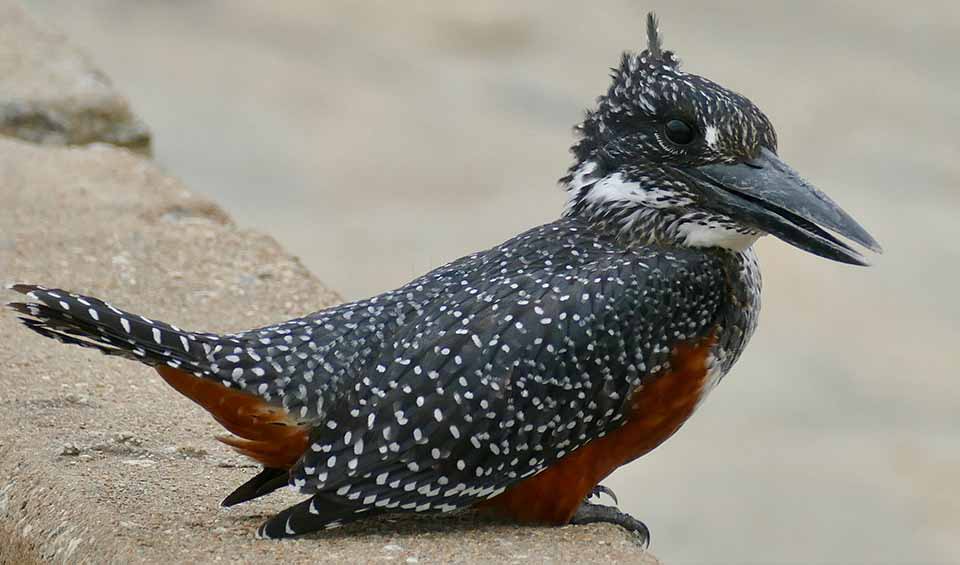A bird that truly lives up to its name with its bold size, booming call, and incredible fishing skills. Found across sub-Saharan Africa, this impressive bird lives near rivers, lakes, estuaries, and wetlands, preferring habitats where clear water offers plenty of fish, crustaceans, and amphibians to hunt. With its commanding presence and sharp-eyed hunting style, the giant kingfisher is a majestic ruler of Africa’s waterways.
The giant kingfisher has a large, heavy bill that looks almost oversized — a perfect spear for catching slippery prey. Its plumage is a beautiful blend of grayish-black with fine white spots, while the underparts vary between sexes: males have a rich, chestnut-red breast, while females have a chestnut belly below a spotted white chest. Both sexes share a shaggy, crested head, giving them a rugged, wild look that suits their powerful hunting style.
Giant kingfishers are expert anglers. They typically perch quietly above water on trees, rocks, or even man-made structures like bridges. Once they spot prey, they launch into a swift, direct dive, plunging deep into the water to seize fish with their strong beaks. Their dives are precise and powerful, and they often return to the same perch to batter larger prey against a branch before swallowing it headfirst. Their diet mainly consists of fish, crabs, frogs, and sometimes even small reptiles.
Giant kingfishers can hover briefly before diving, adjusting their angle mid-air for a more accurate strike. This ability gives them a crucial advantage in fast-moving or murky waters where split-second precision is needed.
Their call is a loud, harsh, rattling cackle, often echoing across rivers and lakes — a familiar sound to anyone who has walked near African waterways. The call is used to declare territory, warn rivals, and maintain contact between pairs.
Distribution
 Angola
Angola Benin
Benin Botswana
Botswana Burkina Faso
Burkina Faso Burundi
Burundi Cameroon
Cameroon Central Af. Rep.
Central Af. Rep. Chad
Chad Congo-Brazzaville
Congo-Brazzaville Côte D’ivoire
Côte D’ivoire DR Congo (Kinshasa)
DR Congo (Kinshasa) Equatorial Guinea
Equatorial Guinea Eritrea
Eritrea Eswatini
Eswatini Ethiopia
Ethiopia Gabon
Gabon Gambia
Gambia Ghana
Ghana Guinea-Bissau
Guinea-Bissau Guinea
Guinea Kenya
Kenya Lesotho
Lesotho Liberia
Liberia Malawi
Malawi Mali
Mali Mauritania
Mauritania Mozambique
Mozambique Namibia
Namibia Niger
Niger Nigeria
Nigeria Rwanda
Rwanda Senegal
Senegal Sierra Leone
Sierra Leone South Africa
South Africa South Sudan
South Sudan Sudan
Sudan Tanzania
Tanzania Togo
Togo Uganda
Uganda Zambia
Zambia Zimbabwe
ZimbabweAnything we've missed?
Help us improve this page by suggesting edits. Glory never dies!
Suggest an editGet to know me
Terrestrial / Aquatic
Altricial / Precocial
Polygamous / Monogamous
Dimorphic (size) / Monomorphic
Active: Diurnal / Nocturnal
Social behavior: Solitary / Pack / Herd
Diet: Carnivore / Herbivore / Omnivore / Piscivorous / Insectivore
Migratory: Yes / No
Domesticated: Yes / No
Dangerous: Yes / No




